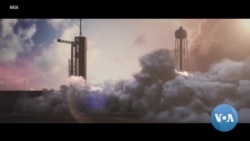ເມື່ອໂຄງການຍານອະວະກາດໄປກັບ ຫຼື Space Shuttle ຂອງອົງ ການອະວກາດສະຫະລັດຫຼື NASA ໄດ້ສິ້ນສຸດລົງໃນປີ 2011 ມີບາງຄົນຄິດວ່າ ມັນຄົງຈະຕ້ອງໃຊ້ເວລາຫຼາຍກວ່າ 8 ປີ ທີ່ບັນດານັກບິນອະວະກາດຂອງສະຫະລັດ ຈະຖືກສົ່ງກັບຂຶ້ນໄປສູ່ວົງໂຄຈອນອີກ ຈາກສູນກາງອະວະກາດເຄັນເນດີໃນລັດຟລໍຣີດາ. ແຕ່ໃນຂະນະທີ່ນັກຂ່າວວີໂອເອ ເຄນ ຟາຣາບໍ ລາຍງານມານັ້ນ ຄວາມຫວັງທັງຫຼາຍແມ່ນກຳລັງສູງຂຶ້ນໃນຂະນະນີ້ ກ່ຽວກັບ “ການແຂ່ງ ຂັນໃນດ້ານອະວະກາດ” ຮອບໃໝ່ ດ້ວຍລະບົບການນຳສົ່ງຂຶ້ນສູ່ອະວະກາດ ທີ່ໄດ້ພັດທະນາໂດຍບໍລິສັດເອກະຊົນ ທີ່ໄດ້ນຳມາໃຊ້ໃນຍຸກສະໄໝໃໝ່ ເພື່ອການສຳຫຼວດອະວະກາດຂອງສະຫະລັດ ຊຶ່ງໄຊຈະເລີນສຸກ ຈະນຳເອົາລາຍລະອຽດກ່ຽວກັບເລື້ອງນີ້ ມາສະເໜີທ່ານ ໃນອັນດັບຕໍ່ໄປ.
ເຖິງແມ່ນຈະນຳໃຊ້ເຄື່ອງມືຕ່າງໆຢູ່ທີ່ ຫໍທ້ອງຟ້າຈຳລອງ ແອດເລີຂອງນະຄອນຊິຄາໂກ ນັ້ນກໍຕາມ ຜູ້ອຳນວຍການດ້ານດາຣາສາດຢູ່ທີ່ຫໍທ້ອງຟ້າຈຳລອງ ແອດເລີ ທ່ານເກຊາ ກີຢຸກ ກໍຍອມຮັບວ່າ ມັນຍັງມີຂໍ້ຈຳກັດຕໍ່ສິ່ງທີ່ເພິ່ນສາມາດແນມເຫັນ ແລະການເຮັດໃຫ້ເຂົ້າໃຈໄດ້ ໃນເລື້ອງຈັກກະວານ.
ທ່ານກີຢຸກ ກ່າວວ່າ “ພວກເຮົາມີກ້ອງສ່ອງດາວ ຂະໜາດ 24 ນິ້ວ ຢູ່ດ້ານຫລັງຂອງສູນແອດເລີ - ມັນບໍ່ແມ່ນບ່ອນທີ່ດີເລີດສຳລັບການສັງເກດດາວ ເພາະວ່າ ແສງໄຟທັງໝົດຖືກປົກປິດຈາກມົນລະຜິດຂອງນະຄອນຊິຄາໂກ.”
ກໍຍ້ອນເຫດຜົນອັນນັ້ນ ທ່ານກີຢຸກ ຈຶ່ງກາງຕໍ່ການທົດລອງຕ່າງໆ ແລະອຸປະ ກອນທີ່ນຳໃຊ້ໂດຍພວກນັກບິນອະວະກາດ ຢູ່ເທິງຊັ້ນບັນຍາກາດຂອງໂລກ ໃນສະຖານີອະວະກາດສາກົນ ຫຼື ISS ນັ້ນ ເພື່ອຊ່ອຍໃຫ້ເພິ່ນ “ເຫັນ” ບໍ່ພຽງແຕ່ຈັກກະວານເທົ່ານັ້ນ ໃນທາງໃໝ່ໆແລະແຕກຕ່າງ ແຕ່ຍັງເຫັນໂລກ ຈາກເບື້ອງເທິງນຳດ້ວຍ.
ມັນເປັນພາກສ່ວນນຶ່ງໃນຂີດຈຳກັດທີ່ສຳຄັນດ້ານວຽກງານຂອງເພິ່ນ ນັບຕັ້ງແຕ່ຍຸກສະໄໝ ຍານອະວະກາດໄປກັບ Space Shuttle ໄດ້ສິ້ນສຸດລົງ ເຮັດໃຫ້ສະຫະລັດຕ້ອງກາງຕໍ່ຣັດເຊຍ ເພື່ອນຳສົ່ງພວກນັກບິນອະວະກາດ ໄປຍັງສະຖາ ນີອະວະກາດ ແລະຍ້ອນອັນນັ້ນ ທ່ານກີຢຸກ ຮູ້ສຶກຕື່ນເຕັ້ນທີ່ຈະໄດ້ຊົມພວກນັກບິນອະວະກາດຖືກສົ່ງຂຶ້ນ ຈາກສູນອະວະກາດແຄມຝັ່ງທະເລ ໃນລັດຟລໍຣີດາ ຊຶ່ງເປັນສິ່ງທີ່ທ່ານ ບໍ່ໄດ້ເຫັນມາໄດ້ເກືອບປີແລ້ວ.
ທ່ານກີຢຸກ ເວົ້າວ່າ “ຂ້າພະເຈົ້າ ຈະເບິ່ງຢູ່ໃນການຖ່າຍທອດສົດຜ່ານທາງອອນລາຍນ໌ ແລະຈະຊົມຊື່ນພາບອັນງົດງານນັ້ນ.”
ເມື່ອໃດທີ່ ນັກບິນອະວະກາດ ທ່ານ ບອບ ເບັນເກັນ ແລະ ທ່ານດັກ ເຮີລີ ທະຍານຂຶ້ນໄປ ຈົນຮອດວົງໂຄຈອນ ແລະຕໍ່ຈາກນັ້ນບິນໄປຈອດທີ່ສະຖານີອະວະກາດສາກົນ ຊຶ່ງພວກເຂົາເຈົ້າ ເຮັດເຊັ່ນນັ້ນໄດ້ແບບເປັນລະບົບ ດ້ວຍການໃຫ້ທຶນສ່ວນນຶ່ງ - ແຕ່ບໍ່ໄດ້ຜະລິດ - ໂດຍທ່ານ ຈິມ ໄບຣເດັນສຕີນ ປະ ຈຳຢູ່ອົງການນາຊ້າ ຮັບຜິດຊອບໂຄງການພານິດດ້ານການຂົນສົ່ງນັກບິນອະວະກາດ.
ທ່ານ ໄບຣເດັນສຕີນ ເຈົ້າໜ້າທີ່ອົງການນາຊ້າ ກ່າວວ່າ “ນາຊ້າ ຈະບໍ່ຊື້ ບໍ່ເປັນເຈົ້າຂອງ ຫຼືຄວບຄຸມອຸປະກອນ. ໃນຄວາມຈິງແລ້ວ ພວກເຮົາຈະເປັນລູກຄ້າ. ພວກເຮົາຈະຊື້ການບໍລິການ.”
ການບໍລິການ ແລະອຸປະກອນ ອັນນັ້ນ ຄື ຈະຫຼວດ Falcon 9 ແລະ ຍານອະວະກາດ Crew Dragon ສໍາລັບພາລະກິດອັນນີ້ ແມ່ນສະໜອງໂດຍ ບໍລະສັດ Space X ຊຶ່ງເປັນບໍລະສັດທຳອິດ ຂອງບໍລິສັດເອກະຊົນຕ່າງໆ ຈຳ ນວນນຶ່ງ ໃນການ “ແຂ່ງຂັນໃນດ້ານອະວະກາດ” ເພື່ອການນຳສົ່ງພວກນັກບິນອະວະກາດ ໃນດານການຄ້າ ເປັນປົກກະຕິ ຈາກເຂດເມືອງ ເຄບ ຄານາເວີໂຣລ.
ພາລະກິດການບິນທົດລອງຄັ້ງທີ 2 ຂອງບໍລິສັດ Space X ໄດ້ຮັບໄຟຂຽວເພື່ອໃຫ້ເດີນໜ້າໄດ້ ເຖິງແມ່ນວ່າ ໃນຂະນະທີ່ໂລກ ກຳລັງຮັບມືກັບການແຜ່ລະບາດຂອງໄວຣັສໂຄໂຣນາຢູ່ນີ້.
ທ່ານດັກ ເຮີລີ ນັກບິນອະວະກາດຂອງອົງການນາຊ້າ ກ່າວວ່າ “ພວກເຮົາໄດ້ຢູ່ພາຍໃນ, ດຽວນີ້ ເພື່ອຄວາມມຸ້ງໝັ້ນ ແລະວັດຖຸປະສົງຕ່າງໆ, ການກັກໂຕໃນບໍລິເວນ ນັບຕັ້ງແຕ່ປະມານ ວັນທີ 15 ເດືອນມີນາ. ພວກເຮົາໄດ້ຢູ່ພາຍໃນການກັກໂຕໃນບໍລິເວນ ບາງທີດົນກວ່າ ພວກລູກເຮືອອະວະກາດຄົນອື່ນໃດ ໃນປະຫວັດສາດຂອງໂຄງການອະວະກາດ.”
ໃນຂະນະທີ່ ພາລະກິດຂອງ ທ່ານເຮີລີ ແລະທ່ານເບັນເກັນນຳມາຊຶ່ງຍຸກສະໄໝໃໝ່ຂອງການບິນອະວະກາດ ທ່ານກີຢຸກ ຊີ້ໃຫ້ເຫັນວ່າ ມັນຍັງຈະຖືກກວ່າເກົ່າອີກ.”
ທ່ານກີຢຸກ ໄດ້ກ່າວອີກວ່າ “ຄ່າສົ່ງຍານອະວະກາດ Shuttle ແມ່ນປະມານເຄິ່ງຕື້ໂດລາ. ຊິ້ນສ່ວນບາງຢ່າງຂອງບໍລິສັດ Space X ນຳມາໃຊ້ຄືນໄດ້ ຄາດໝາຍວ່າ ຈະມີລາຄາປະມານ 50 ລ້ານໂດລາ. ອັນນັ້ນ ແມ່ນອັດຕາຄວາມແຕກຕ່າງຄູນ 10 ເທົ່າ. ການສົ່ງທີ່ຖືກກວ່າ ໝາຍຄວາມວ່າມີໂອກາດຫຼາຍຂຶ້ນສຳລັບພວກເຮົາ.”
ນັກບິນອະວະກາດຜູ້ທີ່ໄດ້ກະສຽນແລ້ວ ທ່ານນາງ ນິໂຄລ ສະຕັອດຕ໌ ກ່າວວ່າ ມັນຍັງເຮັດໃຫ້ອະວະກາດ ເຂົ້າເຖິງໄດ້ຫຼາຍຂຶ້ນ.
ທ່ານນາງສະຕັອດຕ໌ ເວົ້າວ່າ “ຂ້າພະເຈົ້າຄິດວ່າ ແບບທຸລະກິດນີ້ ສຳລັບພວກທຸລະກິດໃດໆເຫຼົ່ານີ້ ທີ່ກຳລັງເຮັດວຽກເປັນຄູ່ພາຄີ ກັບອົງການນາຊ້າ ດຽວນີ້ ແບບທຸລະກິດ ແມ່ນຈະກາງຕໍ່ພວກເຂົາເຈົ້ານັ້ນ ໃຫ້ມີທຸລະກິດຢູ່ພາຍນອກ ນອກເໜືອຈາກພວກນັກບິນອະວະກາດຂອງອົງການນາງຊ້າ ຜູ້ທີ່ຈະຂັບພວກຍານອະວະກາດເຫຼົ່ານີ້.”
ມັນເປັນແບບທຸລະກິດ ທີ່ທ່ານກີຢຸກ ຫວັງວ່າ ອາດນຳໄປສູ່ໂອກາດຫຼາຍຂຶ້ນທີ່ຈະເຮັດ ບໍ່ພຽງແຕ່ເບິ່ງດວງດາວເທົ່ານັ້ນ ຈາກຫໍຟ້າຈຳລອງ ແອດເລີ ຢູ່ເທິງໂລກ.
ທ່ານກີຢຸກ ກ່າວອີກວ່າ “ອັນນັ້ນ ເປັນຄວາມຕື່ນເຕັ້ນແທ້ໆເລີຍ ເພາະວ່າ ອັນນັ້ນໝາຍຄວາມວ່າ ບໍລິສັດ Space X ຍັງຈະສາມາດ ຂາຍບ່ອນນັ່ງ ໃຫ້ຄົນ ອື່ນໆໄດ້ ຄືວ່າ ຂ້າພະເຈົ້າເອງ ບາງທີໃນມື້ໃດມື້ນຶ່ງ ຖ້າຂ້າພະເຈົ້າຢາກຈະເຂົ້າໄປໃນອະວະກາດ ແລະ ຂ້າພະເຈົ້າ ພຽງເຫັນວ່າ ເປັນເລື້ອງທີ່ຕື່ນເຕັ້ນຢ່າງຍິ່ງ ເພາະວ່າ ມັນຈະເປີດກວ້າງອະວະກາດເພື່ອໃຫ້ໝົດທຸກຄົນໄປໄດ້ໃນທີ່ສຸດ.”
ໃນຂະນະທີ່ພວກບໍລິສັດພານິດທັງຫຼາຍ ສຸມໃສ່ການຂົນສົ່ງພວກນັກເດີນທາງໄປອະວະກາດ ເຂົ້າໄປໃນວົງໂຄຈອນຂອງໂລກ ແລະໄປຍັງສະຖານີອະວະກາດຢູ່ນັ້ນ ອົງການນາຊ້າ ກໍບໍ່ໄດ້ປະຖິ້ມການພັດທະນາການສົ່ງຍານອະວະກາດແລະລະບົບນັກລິນອະວະກາດຂອງຕົນເອງເຊັ່ນກັນ. ອົງການນີ້ ໃນປັດຈຸບັນ ກຳລັງ ທົດລອງຈະຫຼວດລຸ້ນໃໝ່ແລະຍານອະວະກາດ ທີ່ຈະນຳເອົາພວກນັກບິນອະວະ ກາດກັບຄືນໄປຍັງດວງຈັນແລະໃນທີ່ສຸດນຳເອົາພວກເຂົາເຈົ້າໄປຍັງດາວພະອັງ ຄານ.
When NASA’s Space Shuttle program ended in 2011, few thought it would take more than eight years for U.S. astronauts to launch back into orbit from Kennedy Space Center in Florida. But as VOA’s Kane Farabaugh reports, hopes ride high on a new “space race” of privately developed launch systems ushering in a new era of U.S. space exploration.
Even by using the tools at Chicago’s Adler Planetarium, Director of Astronomy Geza Gyuk admits there’s a limit to what he can see and do in understanding the cosmos.
(Geza Gyuk, Director of Astronomy, Adler Planetarium)
“We’ve got a 24-inch telescope in the back of the Adler – it’s not a great place to do observing because of all the light pollution from Chicago.”
Which is why he depends on experiments and equipment deployed by astronauts above Earth’s atmosphere in the International Space Station to help him “see” not only the cosmos in new and different ways, but also the Earth from above.
It’s an important part of his work limited since the space shuttle era ended, leaving the U.S. dependent on the Russians for a ride to the space station, and why Gyuk is excited to watch astronauts launch from the U.S. Space Coast in Florida, something he has not witnessed in almost a decade.
(Geza Gyuk, Director of Astronomy, Adler Planetarium)
“I will look at one of the livestreams and enjoy the spectacle.”
When astronauts Bob Behnken and Doug Hurley lift off, reach orbit and then rendezvous with the International Space Station, they will do so in a system partially funded -- but not produced -- by Jim Bridenstine’s National Aeronautics and Space Administration’s Commercial Crew program.
(Jim Bridenstine, NASA Administrator)
“NASA is not going to purchase, own or operate the hardware. In fact, we’re going to be a customer. We’re going to buy a service.”
That service and hardware -- a Falcon 9 rocket and Crew Dragon spacecraft – for this mission is supplied by Space X, the first of several private companies in a “space race” to regularly launch astronauts, commercially, from Cape Canaveral.
The Space X Demo-2 mission got the green light to move forward even as the world copes with the spread of the coronavirus.
(Doug Hurley, NASA Astronaut)
“We’ve been in, for intents and purposes now, a quarantine since about March 15th. // We’ve been in quarantine probably longer than any other space crew has been in the history of the space program.”
While Hurley and Behnken’s mission ushers in a new era of space flight, Gyuk points out it’s also cheaper.
(Geza Gyuk, Director of Astronomy, Adler Planetarium)
“A shuttle launch was about half a billion dollars. A partially reusable Space X is expected to be around 50 million. That’s a factor of 10. Cheaper launches mean more opportunity for us.”
Retired astronaut Nicole Stott says it also makes space more accessible.
(Nicole Stott, Retired NASA Astronaut)
“I think the business model for any of these companies that are working right now in partnership with NASA, the business model is going to depend on them having business outside of just NASA astronauts flying on these spacecraft.”
It’s a business model Gyuk hopes might lead to an opportunity to do more than just look at the stars from the Adler Planetarium on Earth.
(Geza Gyuk, Director of Astronomy, Adler Planetarium)
“That’s really exciting because that means the company – Space X – can also sell the seats to other people, like maybe someday me, if I want to go into space, and I just find that really exciting because it’s going to open up space to everyone eventually.”
While commercial companies focus on transporting space travelers into Earth’s orbit and to the space station, NASA has not abandoned developing its own space launch and crew system. The agency is currently testing a next-generation rocket and capsule that will return astronauts to the moon, and eventually take them to Mars.





